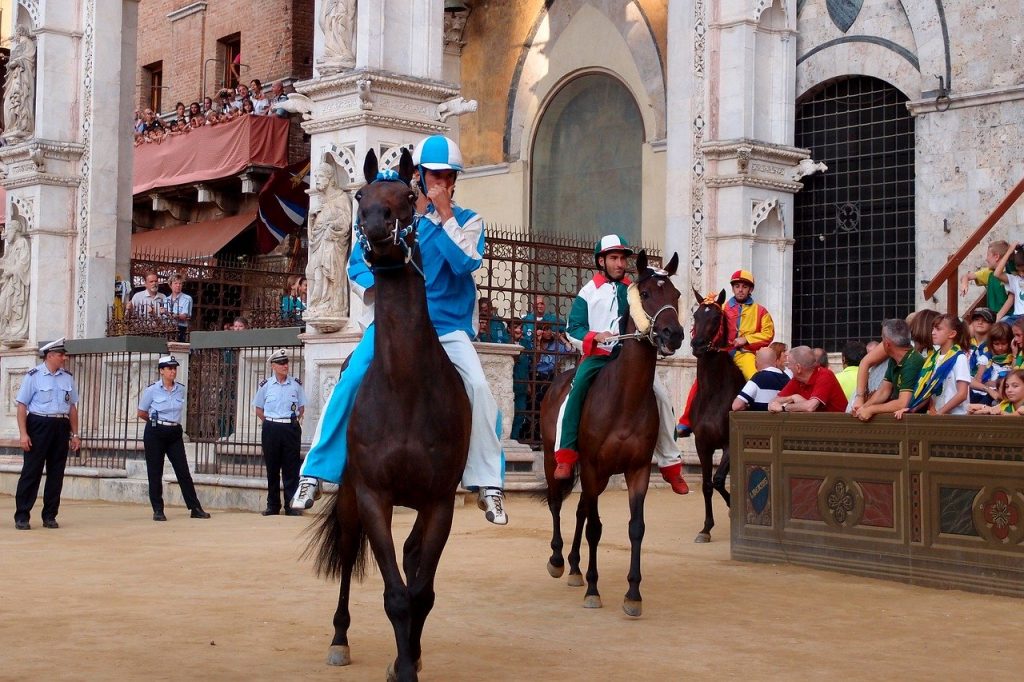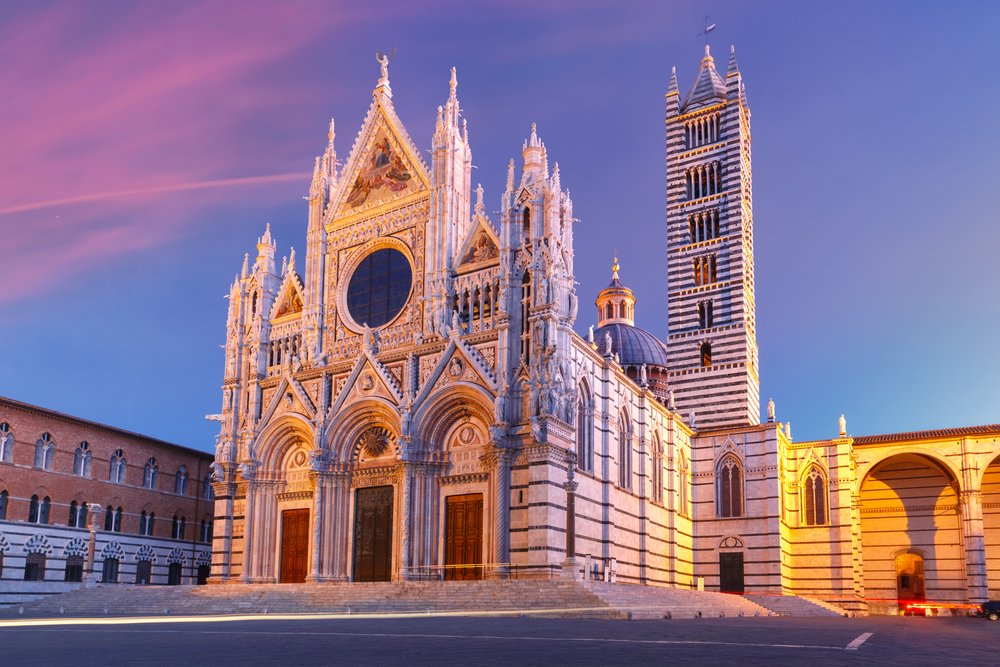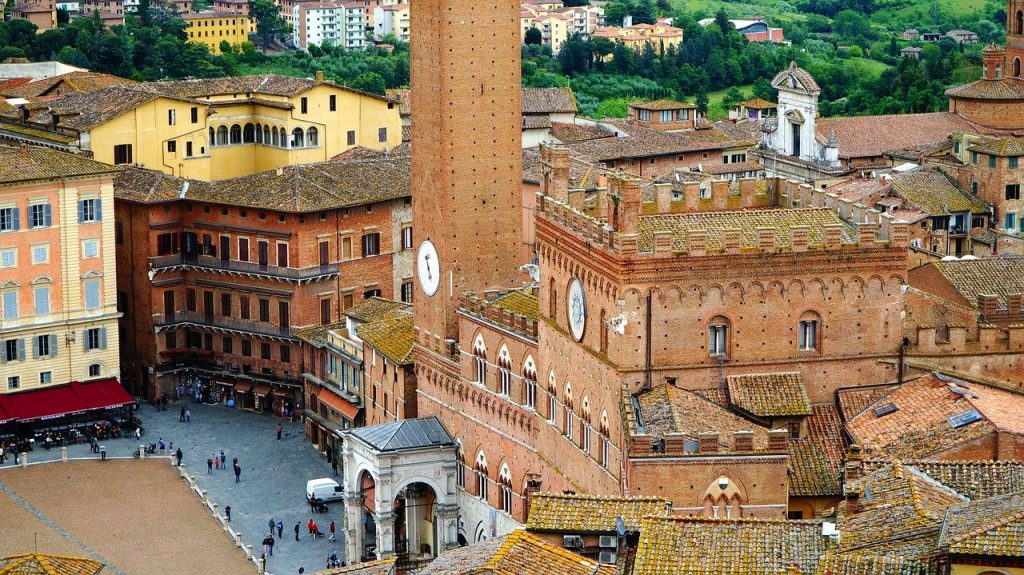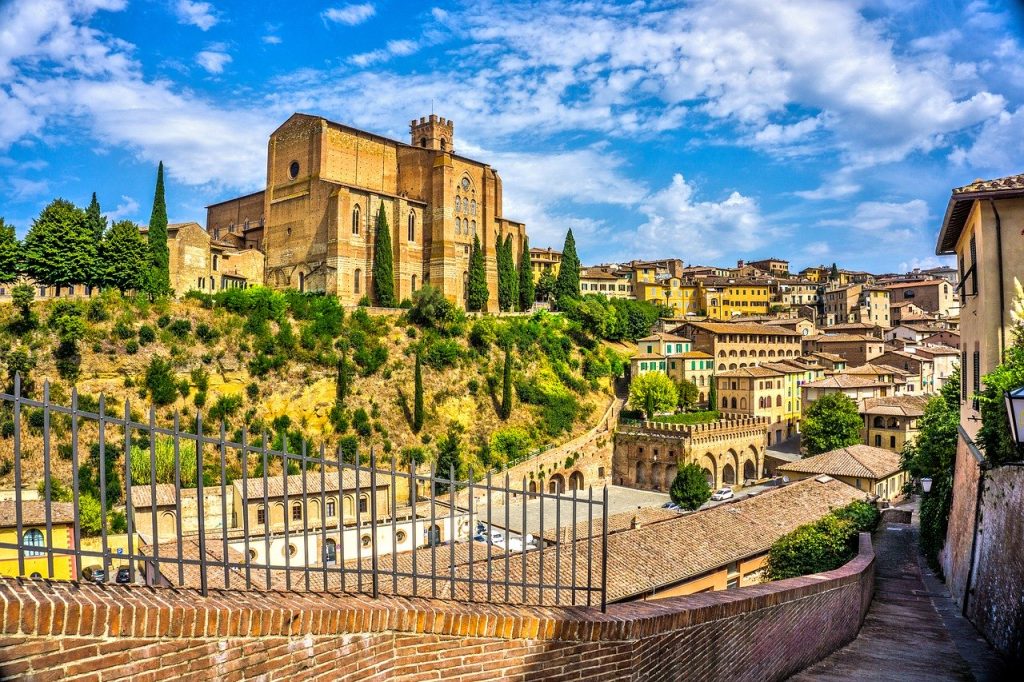2 July and 16 August mark the dates of the annual Siena palio, a tradition that dates back centuries and which involves ten horses and their riders, each one representing one of the wards of Siena, racing three laps around Siena’s central piazza, the Piazza del Campo.
But 2020 marks the year that the Siena palio has been cancelled for the first time since WWII due to the COVID-19 pandemic. A decision described by the Siena Mayor, Luigi De Mossi, as ‘a painful but unanimous decision’, it was simply too risky to carry on as normal given the tens of thousands of spectators that the palio normally attracts to the city.

But, don’t worry! Whatever time of year you visit Siena, there is still plenty to see and do in this wonderful city. Here’s our suggestions for how to spend 48 hours in Siena.
Day 1:
Morning:
A great starting point to get your bearings is to view Siena from above. Head to the iconic central piazza, Piazza il Campo, and climb the 102 metre tall Torre del Mangia. You’ll need plenty of stamina – the tower has 400 steps and the climb can be a bit of a tight squeeze in places – but the breathtaking views over the city from the top are well worth the effort. As you make your way up the stairs, take the time to peek out of the narrow openings that line the walls and catch your breath.
After you have climbed the tower, head to the Duomo. The Duomo is impossible to miss. Its striking black and white striped Gothic facade contrasts with the light brown bricks of the rest of the city.

Pay for a ticket to head inside and you’ll also be getting access to the baptistery, crypt and museum. If you don’t feel you can do justice to everything at once, don’t worry… the ticket is valid for 3 days so you can always pop back again during your stay. The interior is just as beautiful as the exterior. Visitors will find incredible, vividly coloured frescoes by Pinturicchio in the Piccolomini library that is housed within the cathedral as well as works by Pisano, Donatello and Michelangelo. Make sure you look at what’s beneath your feet though. The floor of the Duomo is absolutely stunning. Much of the floor tends to be covered up for most of the year with only a few of the incredible mosaics on display, but if you’re lucky enough to visit between the six and ten weeks each year when the whole of the floor is on view, you’re in for a real treat. The baptistery was built after the main body of the cathedral and is home to a baptismal font designed by Donatello as well as some intricate Renaissance frescoes.
Afternoon:
No doubt you will have built up an appetite by now! Head to Pizzicheria de Miccoli at Via di Citta 95, where you’ll find meats hanging from the ceiling, cheeses galore and a whole host of Tuscan specialities to enjoy. The shop tends to attract a lot of attention from curious passers by, who try to secure a glimpse through the red curtained doorway. Whilst it is more expensive than some of its competitors in the city, the quality is incredibly high and we think that it’s definitely worth the extra expense. Ask for the local red wine to accompany your meal and also try their ricciarelli as they are some of the best we have ever tasted. (Ricciarelli are traditional Italian biscuits which originated in Siena in the 14th century).
While away the afternoon with a visit to Santa Maria della Scala. Once one of the oldest hospitals in Europe, this is now home to an excellent (and extremely large) museum. Inside, you’ll find a real treasure trove with archeological finds, artworks and gems from several different eras. This is a great option for families in particular, with something to please both children and adults alike.
Evening:
No evening in Siena would be complete without enjoying an aperitivo in one of the bars and cafes that line the Piazza del Campo. Ask for an aperol spritz and simply spend an hour or two people watching.
Day 2:
Morning:
There is a wealth of art to discover in Siena and it’s worth devoting at least a morning to uncovering it. Start the day by visiting the Museo Civico in the Palazzo Pubblico, adjacent to the Torre del Mangia where you started your visit to Siena. The building itself dominates the Piazza del Campo and it’s a perfect example of Medieval architecture, albeit with a number of Gothic influences thrown in, boasting a facade that curves sightly inwards reflecting the outward curve of the Piazza del Campo. There is a wealth of art to discover in the Museo Civico here dating back across many different centuries, with almost every room covered in ornate frescoes. But the highlight is certainly the Sala della Pace, home to Ambrogio Lorenzetti’s 14th century ‘Allegories of Good and Bad Government’. The museum, whilst full of artistic delights, isn’t actually that large and so an hour or two is more than sufficient to do it justice.

If your craving for art isn’t satiated by the Museo Civico, then another good stopping point would be the regional art gallery – Pinacoteca Nazionale – where you can find a number of Gothic and Early Renaissance artworks by Italian artists dating from between the 12th and 16th centuries. Some of the most notable works include Lorenzetti’s ‘Madonna Enthroned’ and Guida da Siena’s ‘Raising of Lazarus’ and ‘Entry into Jerusalem.’
Afternoon:
In the afternoon, take the time to explore Siena’s streets and perhaps do a spot of shopping. Via Banchi di Sopra is where you will find most of the shops, especially shops selling clothes, bags and shoes. You’ll also find shops on Via Pantaneto and Via di Citta.
No visit to Siena would be complete without at least some time just spent wandering the city’s streets and we would recommend you spend some ‘unstructured’ time simply exploring the city for yourself.
It’s worth heading to the Church of San Domenico in the western part of the historic town centre. A complete mixture of architectural styles, the exterior is not as striking as the Cathedral but the interior is stunning. The Chapel of Santa Caterina that is housed within it has some beautiful religious frescoes and marble sculptures for example.

Another place where you will find a complete mishmash of styles is the Piazza Salimbeni, a small square in the heart of Siena. Three of its sides are home to three very different palaces – the Palazzo Tantucci, the Palazzo Salimbeni and the Palazzo Spannocchi.
Otherwise, watch out for the 16th century Medicea Fort in the west of Siena and the Porta Pispini where you can also see the original city walls.
Evening:
Siena has a wealth of wonderful restaurants where you can savour the delights of Tuscan cuisine and no visit to the city would be complete without sampling some of them. A couple of our favourites include the Ristorante Grotta Santa Caterina on Via della Galluzza. The food is superb and it’s popular with the locals which is always a good sign! If you go at the weekend, there is always a stream of people being turned away at the door if they haven’t booked so it’s definitely worth booking ahead. The second restaurant which we think also offers exceptional food is Osteria le Logge. The food here is again excellent and a visit here is highly recommended!
If you’re keen to explore the things to see and do in Siena, and are looking for a base in Tuscany, then why not consider Villa Colombaio, a stunning 6 bedroom villa near Siena. Or for something smaller, this stunning 2 bedroom villa in Tuscany is just a short drive from Siena.
